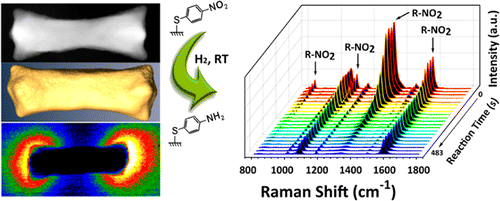

 Surface-enhanced Raman scattering (SERS) is a highly sensitive probe for molecular detection. The aim of this study was to develop an efficient platform for investigating the kinetics of catalytic reactions with SERS. To achieve this, we synthesized a novel Au–Pd bimetallic nanostructure (HIF-AuNR@AuPd) through site-specific epitaxial growth of Au–Pd alloy horns as catalytic sites at the ends of Au nanorods. Using high-resolution electron microscopy and tomography, we successfully reconstructed the complex three-dimensional morphology of HIF-AuNR@AuPd and identified that the horns are bound with high-index {11l} (0.25 < l < 0.43) facets. With an electron beam probe, we visualized the distribution of surface plasmon over the HIF-AuNR@AuPd nanorods, finding that strong longitudinal surface plasmon resonance concentrated at the rod ends. This unique crystal morphology led to the coupling of high catalytic activity with a strong SERS effect at the rod ends, making HIF-AuNR@AuPd an excellent bifunctional platform for in situ monitoring of surface catalytic reactions. Using the hydrogenation of 4-nitrothiophenol as a model reaction, we demonstrated that its first-order reaction kinetics could be accurately determined from this platform. Moreover, we clearly identified the superior catalytic activity of the rod ends relative to that of the rod bodies, owing to the different SERS activities at the two positions. In comparison with other reported Au–Pd bimetallic nanostructures, HIF-AuNR@AuPd offered both higher catalytic activity and greater detection sensitivity.
Surface-enhanced Raman scattering (SERS) is a highly sensitive probe for molecular detection. The aim of this study was to develop an efficient platform for investigating the kinetics of catalytic reactions with SERS. To achieve this, we synthesized a novel Au–Pd bimetallic nanostructure (HIF-AuNR@AuPd) through site-specific epitaxial growth of Au–Pd alloy horns as catalytic sites at the ends of Au nanorods. Using high-resolution electron microscopy and tomography, we successfully reconstructed the complex three-dimensional morphology of HIF-AuNR@AuPd and identified that the horns are bound with high-index {11l} (0.25 < l < 0.43) facets. With an electron beam probe, we visualized the distribution of surface plasmon over the HIF-AuNR@AuPd nanorods, finding that strong longitudinal surface plasmon resonance concentrated at the rod ends. This unique crystal morphology led to the coupling of high catalytic activity with a strong SERS effect at the rod ends, making HIF-AuNR@AuPd an excellent bifunctional platform for in situ monitoring of surface catalytic reactions. Using the hydrogenation of 4-nitrothiophenol as a model reaction, we demonstrated that its first-order reaction kinetics could be accurately determined from this platform. Moreover, we clearly identified the superior catalytic activity of the rod ends relative to that of the rod bodies, owing to the different SERS activities at the two positions. In comparison with other reported Au–Pd bimetallic nanostructures, HIF-AuNR@AuPd offered both higher catalytic activity and greater detection sensitivity.